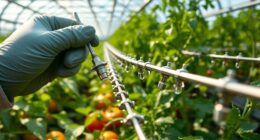To keep your greenhouse tools in top shape, sterilize them regularly using alcohol or diluted bleach solutions to prevent pests and diseases. After sterilizing, dry your tools thoroughly and store them in a dry, organized space like a wall rack or toolbox to avoid rust and damage. Protect them from moisture and damage by using proper storage methods, such as hanging or shelving, which also makes tools easy to find. Keep going to discover more expert tips.
Key Takeaways
- Sterilize tools regularly with alcohol or diluted bleach to prevent disease spread among plants.
- Dry tools thoroughly after sterilization to avoid rust and corrosion.
- Store tools in a dry, organized space using racks, shelves, or designated containers.
- Use silica gel packs or dehumidifiers to control humidity and prevent rust formation.
- Keep tools sharp and well-maintained to ensure efficient, safe gardening and prolong their lifespan.

Tools are the backbone of any project, and maintaining them in top condition guarantees they perform reliably and last longer. Whether you’re working on greenhouse maintenance or general gardening, keeping your tools in prime shape is essential. One pivotal aspect is hand tool sharpening. Dull tools can make your work harder, decrease efficiency, and even damage plants or materials. Regularly sharpening your hand tools, like pruners, shears, and hoes, ensures clean cuts and smooth operation. Use a sharpening stone or a file suited for the tool’s blade to maintain a sharp edge. Take care to follow the manufacturer’s guidelines for sharpening angles and techniques, and always clean tools thoroughly after sharpening to prevent rust. Proper storage solutions, such as wall-mounted racks or dedicated toolboxes, help protect tools from moisture and damage.
But maintaining tools isn’t just about sharpening; proper equipment storage solutions are equally important. Storing your tools correctly prevents damage, rust, and clutter, making them easier to find and use when needed. Invest in quality storage options like wall-mounted racks, toolboxes, or shelving units designed specifically for gardening equipment. Keep your hand tools dry and protected from moisture, which accelerates corrosion. Consider using silica gel packs or dehumidifiers in storage areas to control humidity levels, especially in damp environments like greenhouses. Hanging tools by their handles prevents warping and keeps blades from dulling prematurely. For smaller hand tools, a dedicated drawer or container with compartments can keep everything organized and accessible. Regular sterilization of your tools is crucial for preventing the spread of pests and diseases among your plants.
Sterilizing your greenhouse equipment is another critical step in tool maintenance, especially if you’re working with plants susceptible to pests or diseases. Regularly sterilize pruning shears, trowels, and other tools to prevent the spread of pathogens. Use a solution of isopropyl alcohol or a diluted bleach mixture to wipe down blades and handles after each use. This practice not only prolongs the life of your tools but also safeguards your plants’ health. Remember to dry tools thoroughly after sterilizing to avoid rust, and inspect them regularly for signs of wear or corrosion. Incorporate sterilization into your routine maintenance schedule to stay ahead of potential problems. Incorporating proper sterilization techniques helps ensure your tools remain safe and effective over time.
In all, combining diligent hand tool sharpening with effective equipment storage solutions and regular sterilization creates a thorough approach to tool maintenance. This ensures your greenhouse tools remain reliable, safe, and ready for action whenever you need them. Taking the time to care for your equipment now pays off in the long run, reducing replacement costs and improving the success of your gardening efforts. Proper maintenance is an investment that keeps your tools performing at their best, helping you achieve healthier plants and more productive work sessions.
Frequently Asked Questions
How Often Should Greenhouse Tools Be Sterilized?
You should sanitize your greenhouse tools after each use, especially when switching between different plants or working in contaminated areas. Regular sterilization boosts tool durability and prevents disease spread. In general, sterilization frequency depends on your activity; sterilize more often if you’re dealing with susceptible plants or pests. Consistently maintaining this routine keeps your tools in top condition and ensures a healthy greenhouse environment.
What Are the Best Storage Conditions for Greenhouse Tools?
You should store your greenhouse tools in a dry, cool place with good ventilation to prevent rust and mold. Use sturdy storage containers or tool racks for organization, keeping sharp blades separate and accessible. Make sure tools are thoroughly cleaned and sterilized before storing. Proper tool organization and the right storage containers will safeguard your equipment, prolong its lifespan, and ensure you’re ready for your next gardening session.
Can Sterilizing Solutions Damage Certain Greenhouse Equipment?
Did you know that improper sterilizing solutions can cause up to 30% of greenhouse tool damage? Yes, certain solutions can trigger chemical reactions that harm specific materials. Always check the label for material compatibility. For example, metal tools may corrode with harsh chemicals, while plastics can crack or degrade. To prevent damage, choose sterilizing agents suited for your equipment and follow manufacturer instructions carefully.
How Do I Prevent Rust on Stored Tools?
To prevent rust and make certain your tools last longer, always clean them thoroughly after use and dry them completely before storage. Apply a light coat of oil or rust inhibitor to metal parts to create a protective barrier. Store your tools in a dry, well-ventilated area, preferably hanging or in a toolbox. Regularly inspect and maintain your tools to boost rust prevention and maximize their tool longevity.
Are There Eco-Friendly Sterilization Options Available?
Yes, eco-friendly sterilization options are available for your greenhouse tools. You can use biodegradable sterilizers that break down naturally without harming the environment, or natural disinfectants like vinegar, hydrogen peroxide, or essential oils. These alternatives effectively sanitize your tools while avoiding harsh chemicals. By choosing biodegradable sterilizers and natural disinfectants, you protect your plants, your soil, and the planet, ensuring sustainable and safe greenhouse practices.
Conclusion
Properly sterilizing and storing your greenhouse tools might seem time-consuming, but it’s essential for healthy plants and long-lasting equipment. Skipping these steps can lead to pests and diseases that cost you more in the long run. By dedicating just a few minutes after each use, you protect your garden’s future. Remember, careful maintenance isn’t just about tools — it’s about ensuring your greenhouse thrives season after season.









